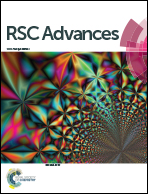Low-cost multilevel microchannel lab on chip: DF-1000 series dry film photoresist as a promising enabler†
Abstract
We demonstrate the use of a novel dry film photoresist DF-1000 series for the fabrication of multilevel microfluidic devices by combining a standard lithography technique and lamination technology. The optimization of the technological process enables achievement of high aspect ratio structures: 7 : 1 for free standing structures and 5 : 1 for channel structures. We proved that DF films feature a low autofluorescence level, similar to that of the SU-8 resist and compatible with most lab-on-a-chip applications. The chemical stability against aggressive solvents was also investigated. Last but not least, the non-cytotoxic effect according to ISO 10993-5 on the development of L-929 mouse fibroblast cells was established. Ultimately, we showed that this low-cost material combined with multilevel lamination and UV-lithography techniques allowed the fabrication of 3D microfluidic mixers and opened the way to perform microfluidics in three dimensions.


 Please wait while we load your content...
Please wait while we load your content...